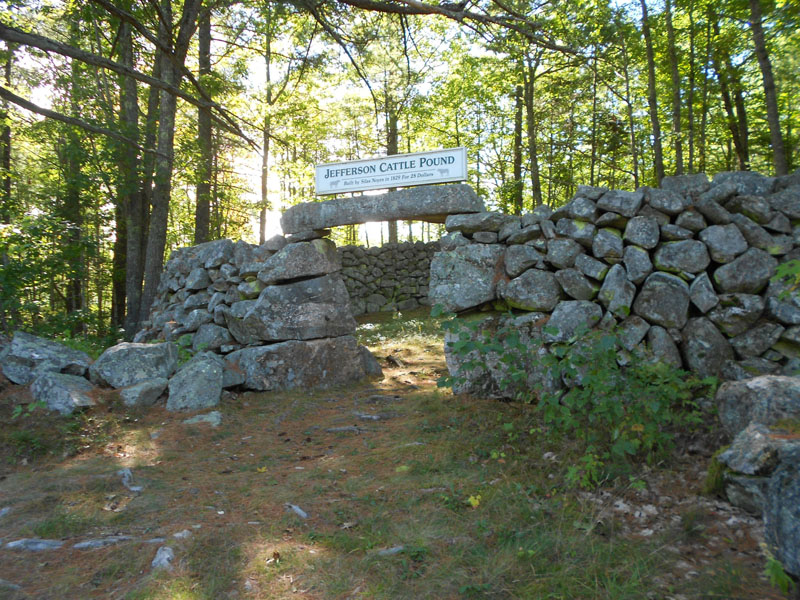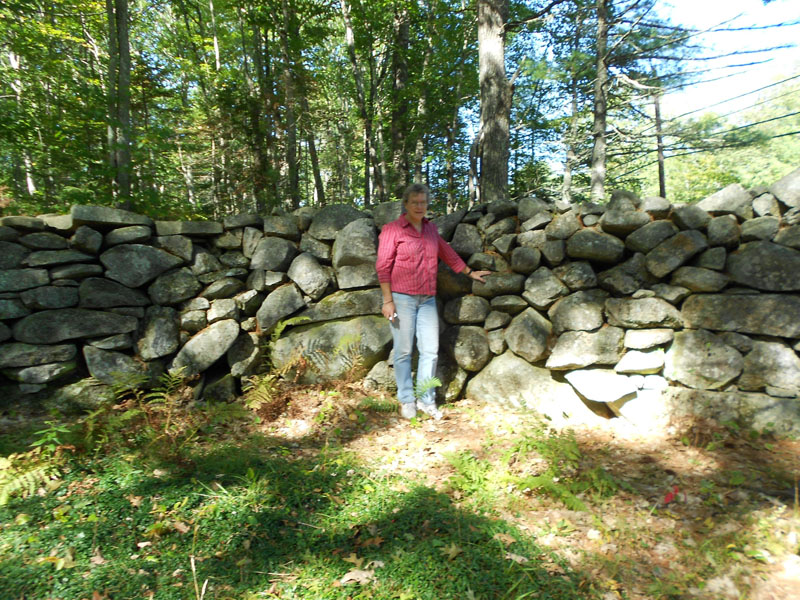
In 1829, Silas Noyes built the Jefferson Cattle Pound next to Route 126. The circular stone wall is about 6 feet high, enclosing a space about 40 feet wide on the inside. (Photo courtesy Arlene Cole)
Some time ago I was interested to hear on my television authorities in Maryland were looking for two stray cows. I don’t know where. Then, they had pictures of a flock of sheep roaming free in Gardiner.
Both wandering geese and cows would have been a regular occurrence in Newcastle many years ago. Stray cows, horses, or oxen were common.
They would have been collected and lodged in a pound until the owner came to claim them. Sheep would have been left alone. They were allowed to forage freely for food.
Animal pounds were an important part of rural life. A pound is an enclosure maintained by a town in which stray animals were confined when recovered after going at large in violation of the law. The animals could redeemed by payment of a fine.
In early Newcastle this was a very important item and a pound keeper was elected to take care of these issues. Pounds required time and effort to build and many a pound keeper found it necessary to keep stray animals in their own barns on occasion.
A pound could be plain, homely, and cheaply built, but with strong, high walls and well-secured by gates, locks, and bars. It essentially was a prison for farm animals that strayed beyond their own enclosure. Here they were forced to lie down within the walls and feed only on what they were given by the field drivers.
Besides the pound for stray cattle and horses, regulations allowed small animals to run free. Fowl, swine, rams, and sheep were all free to roam as they pleased. They were expected to get much of their food from wandering around.

Jefferson Cattle Pound builder Silas Noyes was a skilled dry mason. He fitted the stones together with such exquisite care they have survived countless frosts for 194 years and still stand intact. (Photo courtesy Arlene Cole)
The farmer was sure to have his garden fenced in. Although today our dogs cannot run free, in those days the farmer left his dogs running free to drive off his neighbor’s wandering animals.
The Rev. David Quimby Cushman writes in his book, “The History of Ancient Sheepscot and Newcastle” there was a pound at Sheepscot, but another was necessary.
According to early town records, at a town meeting held on April 7, 1757, it was voted that a pound would be built on each side of the town.
Later, Cushman notes the inquiry was raised, why the pound was not built at the time and place appointed, when it was agreed to build two pounds in 1757.
Newcastle residents subsequently agreed to build another pound near Capt. Alexander Nickles who lived in the center of the town. This pound was to be built on May 28 and the entire male force of the town was to turn out and do the work, beginning at 8 a.m. It was to be built of timber.
“And it was ordained at that moral time, by the authority of the new kingdom, in town meeting assembled, that every man who failed to meet, or send his substitute, at the time and place appointed, should forfeit and pay two shillings to them and for their benefit, who did work,” Cushman wrote. “Wise and forcible legislation! But the people did not do it. And there was no power behind the throne to compel it.”
Some towns did build substantial pounds. There is one cattle pound that has stood the test of time. In 1829 a man named Silas Noyes built the Jefferson cattle pound on Route 126. A skilled dry mason, Noyes built a circular stone wall over 6 feet high and 40 feet wide inside. He charged $28. The pound seems as impregnable today as when Noyes built it.
There were problems, also, in town, as the livestock ran free. In 1761 the town voted that swine have liberty to go at large if they were properly yoked and ringed. Two hog constables were appointed to keep watch. Farmers were not happy about this freedom. Even yoked and ringed swine could raise havoc with farmer’s gardens.
In 1762 the town voted that all rams owned or kept in town should be kept from the sheep from August to November. Sheep and lambs were free to roam.
In 1763 the town ordained that no stallion older than a year should be allowed to run at large. As late as 1775, Samuel Kennedy was allowed the privilege of putting a gate or bars across that part of the town road that led by his barn to keep out wanderers. This meant anyone driving by his barn had to get out and open the gate to get by on the town road.
In 1767 a pound was ordered to be built as highway work, at Sheepscot, on the spot where the old one stood. A committee was appointed to select a place for a pound on the Eastern side of town, and it was ordered that it should be built as highway work.
Apparently it was not done that year, for at the next town meeting in March, residents agreed to build a pound on the eastern side of town, at the most convenient place to accommodate people and “handy to water.”
Here, Cushman gives up trying to follow the pounds.
As late as May 1800 there were, apparently, still pounds for keeping stray cattle and horses. The owner had only to call and prove it was his property.






